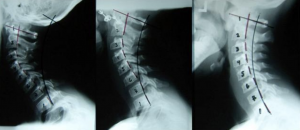It’s safe to say that a majority of our population has a smartphone, sometimes two. Unfortunately, we all are susceptible to neck pain, more recently known as “tech neck” syndrome. However, small changes to the way you consume content on your phone can make all the difference between a healthy neck and one that hurts from all that texting.
It’s not uncommon to see a patient walk into Bounceback Physiotherapy Clinic with a twelve-pound head that’s migrated three inches forward on their body because of Forward Head Posture (FHP). FHP is a common problem for many people, among other postural issues. Over time, it will cause substantial damage to the spine, in what is otherwise a preventable injury. Did you know for every inch of FHP, the weight of the head on the spine increases by an additional 10 pounds?

The extensive spread of this particular postural issue is partly due to our society’s addiction to prolonged sitting, and through excessive use of tablets and smartphones. By doing so, your forward posture can add up to 30 pounds of abnormal leverage on the cervical spine.
Forward Head Posture has also been shown to affect the brain in negative ways. Research shows that 90 percent of the stimulation and nutrition to the brain is generated by the movement of the spine. Therefore, less cervical movement results in less nutrition to the brain. Only 10 percent of the brain has to do with thinking, metabolism and healing. Consequently, FHP will cause the brain to rob energy from thinking, metabolism and your immune function to deal with the abnormal gravity/posture relationships and processing.
Here are four simple strategies and stretches that will tackle that strain and pain.
Hold your phone … differently
Neck problems from cell phones can be fixed simply by bringing your phone a little closer to your face. Ultimately, you decide on positioning; your phone doesn’t. By putting 10 degrees of extension in your neck (bringing your head back up) can alleviate about 10 pounds of sustained weight on your neck. As long as you’re more conscious about positioning, it’ll help you find opportunities to bring your phone up to your face.
Text less
We have lost our ability to make more genuine connections. We rarely call to wish each other happy birthday anymore, for example. We pretty much say all of our well wishes with one emoji. In an age when hearing a voice over the phone is rare, take the advantage by making a call. It could set you apart in many ways and even give you a competitive edge.
Tuck your elbows in
Tucking your elbows in provides you with a checkpoint. When you tuck your elbows into your body it gives you no room to drop your arms down any more. When your arms drop down, your head will just end up following.
Do some simple neck exercises
Working on these deep neck flexors is an excellent way to create a stretch of the posterior neck muscles that tend to tighten up. It also builds the strength of the muscles deep in the front of the neck that tends to get weaker and inhibited due to constantly being on the phone.
• Lie on your back.
• Tuck in your chin slightly.
• Raise your head up just high enough to force you to contract the muscles in the front of your neck against gravity.
• Slowly continue to raise your head into more neck flexion (chin down to chest).
• Don’t let your chin jut forward.
• Hold for 30 seconds (or however much time you can tolerate; many of you will become quite tired after 10 seconds).
• Repeat three times daily (ideally, doing it at meal times is a good way to remember).
This article originally ran in 2018.





